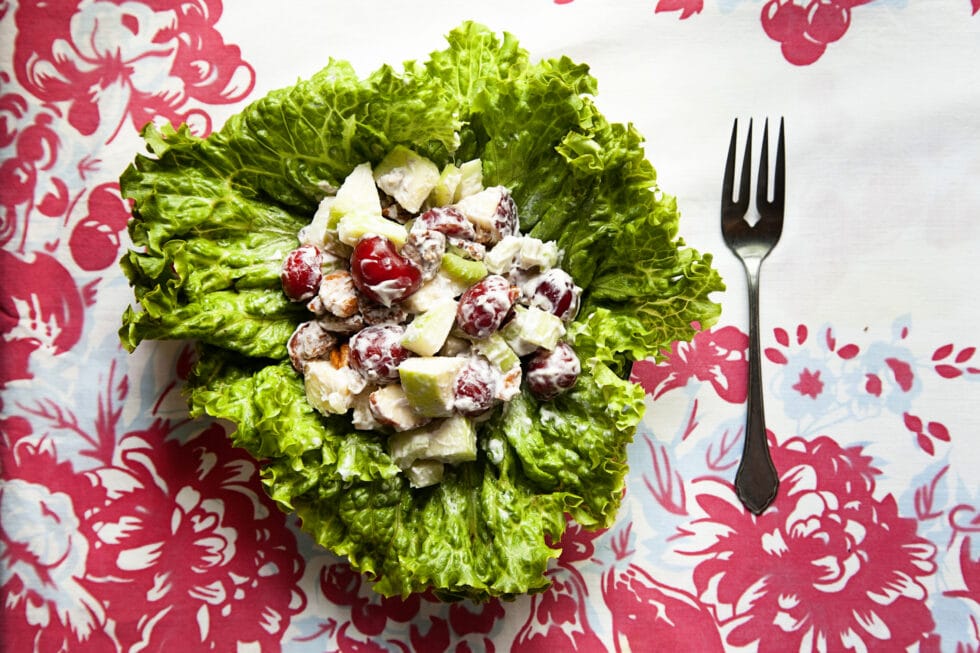
Low Histamine Waldorf Salad Recipe (Also Low Lectin, Medium Oxalate, and with Low Salicylate Options!)
I regularly eat Rosemary Chicken Salad and Low FODMAP Baru Nut Crusted Chicken Over Salad for lunch.
These recipes have become a go-to for me because they are so easy to make.
But I’ve eaten them so much recently, I started wanting a change.
I still wanted something quick, though.
So, I went online looking for some options. And I came across the Waldorf salad.
If you aren’t familiar with it, the Waldorf salad is a type of fruit and nut salad with a creamy dressing. It’s often served on a bed of lettuce.
Where did the original Waldorf salad come from?
Credit for its creation goes to Oscar Tschirky. He was the maître d at the Waldorf-Astoria Hotel in New York City.
Interestingly, he was never a chef!
But he collaborated with the hotel chef to create several of the Waldorf-Astoria’s signature dishes.
It’s been a long time since I’ve had Waldorf salad! So, this looked like a fun choice.
As you can imagine, though, the classic Waldorf salad is made with some no-no ingredients if you have certain food intolerances.
But I like a challenge. Actually, this recipe was really easy to change!
Keep reading for a Waldorf salad recipe that’s:
- low histamine
- medium oxalate
- low lectin
- low salicylate (optional)
Then keep reading to see:
- the swaps I made and why
- prep tips
- highlights of the health benefits of the ingredients
I like to share this info with you so you can start making changes to your own recipes, too.
First, take a look at the ingredients in the classic Waldorf salad recipe.
Are there any that you can already pinpoint as high histamine?
Classic Waldorf Salad Recipe
The original recipe for Waldorf salad uses some ingredients that may not be the best choices if you have Histamine Intolerance or Oxalate Intolerance.
It usually calls for:
- apples
- grapes
- walnuts
- celery
- mayonnaise
- sour cream
- yogurt
Celery, grapes, and apples are the only ingredients that aren’t high histamine or high oxalate.
Grapes often have yeasts and mold on them that can be a problem for some people with MCAS.
But with just a few easy swaps, you can make a tasty, low histamine Waldorf salad recipe.
Related Article: Low Histamine Food List
I’m planning on adding this Waldorf salad to my lunch rotation.
And because it’s so easy to make, you might be adding it to your weekly meal plan, too!
But in addition to lunch, you can serve it other ways, too.
It can be an appetizer or a side dish to bring to a potluck.
It’s also popular for brunch or as light meal.
Next up: the swaps I made and why.
Low Histamine Swaps for Waldorf Salad Recipe
You just saw the ingredients in the classic Waldorf salad recipe.
Now, if you have salicylate intolerance, you’ll need to look at what type of apple you are choosing.
You’ll also need a different option for your grape swap. I’ve got all that info coming up.
Here are the low histamine, low oxalate swaps to make and why.
Pecans
Swapped for:
Walnuts
Why:
Walnuts are high histamine and high oxalate.
Pecans are medium oxalate at up to 1/4 cup. This recipe uses 1/2 cup total. It serves 4.
That means each serving will only have 1/8 cup. That’s considered within the medium oxalate range.
Pecans are also low salicylate.
TIP: Soak your pecans.
In the past, I’ve soaked pecans in salt water.
But I learned that alkaline water helps more with reducing mycotoxins and oxalates.
Adding baking soda makes the water more alkaline.
I put the nuts in a large bowl and cover them with filtered water.
Then I add about 1 Tablespoon of baking soda for every cup of nuts.
I soak them for about 12-24 hours in the refrigerator.
If I’m doing a bunch at once, I’ll then rinse them and put them in a food dehydrator.
But for this recipe, you only need a small amount. You can soak and rinse them and then use them immediately in the Waldorf salad or you can dry them.
Cherries
Swapped for:
Grapes
Why:
Grapes tend to have a lot of mold.
Visually, cherries add a pop of color to your dish like red grapes do.
With food intolerances, we may be a little more lax in what our food looks like.
But when something doesn’t set off reactions and it looks really appetizing, too… bonus!
Plus, if you’re serving it to other people, it just dresses it up a little.
Here’s something that I think is more important with recipe swaps — taste and texture.
For taste, grapes are sweet. So are cherries. Easy enough.
In terms of texture, grapes can have a crispness to them. But they are also soft.
Cherries will give you a similar texture.
Overall, they give a contrast in texture to the crisp apples and crunchy nuts.
TIP: Buy frozen, pitted cherries to save on preparation time. Fresh tastes best, but frozen cherries can work well in this recipe too.
Be sure to get organic cherries. Conventional cherries are very high in pesticides.
Low Salicylate or Low Oxalate Options:
Try a soft pear (peeled) instead if you have salicylate intolerance.
Stick with Bartlett or Bosc if you have oxalate intolerance.
Pears are a nice contrast with the crunch of apples.
Cherries are fine if you don’t have salicylate intolerance.
But if you do have salicylate intolerance, you’ll want to go with peeled pears rather than cherries.
Coconut Cream
Swapped for:
- mayonnaise
- Greek yogurt or plain yogurt
- sour cream
These are the traditional ingredients used to make the creamy dressing.
Why:
Mayonnaise, Greek yogurt, plain yogurt, and sour cream are all high histamine.
Yogurt and sour cream are fermented, making them high histamine.
Some of them have preservatives that can be either high histamine or trigger mast cells.
And some people have trouble processing dairy…especially in the early stages of addressing food sensitivities.
That’s why I only suggest whipped cream (dairy) if you have salicylate intolerance. Because I want you to have options if you’re limited in foods.
But coconut cream is my go-to as a substitute for creamy foods like yogurt or sour cream.
I’ve used it in everything from stroganoff to coffee drinks to salad dressing. Coconut cream makes a great swap.
TIP: Choose a coconut cream that just has the ingredients coconut and water.
Be careful to avoid emulsifiers and other preservatives which may contribute to leaky gut or MCAS or Histamine Intolerance.
The one I am now recommending is Let’s Do…Organic Coconut Cream. (You can read more about why in this post.)
And no, they don’t use BPA in the lining of the cans, fortunately!
Low Salicylate Option:
Coconut cream works great for most people. So, it’s only a concern if you have salicylate intolerance.
Cream is low salicylate, though.
I don’t usually recommend dairy products if you are in the early stages of your addressing Mast Cell Activation Syndrome and Histamine Intolerance. Particularly when you’re working on repairing your gut.
But if you tolerate cream and you have salicylate intolerance, you could sub cream (whipped) for the coconut cream.
If you’re going to use cream, I highly recommend getting grass-fed for better nutrients and to avoid all the chemicals in conventional dairy.
You want to thicken it, though, to use in this recipe. Just put the cream in a bowl. Use a mixer to whip the cream until you get stiff peaks.
That means that when you lift your mixer out of the bowl, the mixture will stand up straight with a small curl at the tip.
Apples
You don’t need to swap out apples. But I wanted to mention it because you may need to pay attention to the type of apple you use.
Apples are low histamine. For this recipe, you can use any kind of apple if Histamine Intolerance is your only concern.
For example, you can use crisp apples like Granny Smiths. These give you a hint of tang.
Fuji apples are crisp apples, too. But they tend to be sweeter than Granny Smith.
You can choose based on your taste preference.
You only need to consider what kind of apple to use if you have salicylate intolerance.
To make this recipe low salicylate:
Use:
Peeled golden or red delicious apples
Why:
Apples are a high salicylate food
TIP: Apples are on the “Dirty Dozen” food list. That means if they are conventionally grown, they can have a lot of pesticide residue.
This is one food you definitely want to get organically grown.
Now that you know why you should use these swaps, take a look at some of the benefits of these ingredients.
After that, I’ve got the recipe for you. And I’ve got some ideas on how to serve it, too!
Top Health Benefits from Low Histamine Waldorf Salad Recipe
You can support your health by getting nutrients out of the foods you eat.
Take a look at what you’ll get from this recipe:
Quercetin
Quercetin is found in apples. Most of the quercetin is found in apple skins.
So, if you don’t have salicylate intolerance, you’ll want to keep those skins on.
Quercetin has been shown to have:
- anti-inflammatory properties
- antioxidant properties
- mast cell stabilizing properties
Magnesium
Just one cup of pecans has about 120 mg of magnesium.
Cherries also contain magnesium
Magnesium can support you if you have Histamine Intolerance.
Here’s how:
Your body needs magnesium to make the histamine degrading enzyme called diamine oxidase (DAO).
If your body isn’t making enough DAO to keep up with your histamine load, histamine can build up in your body.
This buildup of histamine is what leads to Histamine Intolerance.
HNMT is another enzyme that breaks down histamine.
This enzyme is made in a process called methylation.
The methylation cycle also needs magnesium.
Helping make histamine degrading enzymes is just one way magnesium can be helpful.
Related Article: Mast Cell and Histamine Safe Forms of Magnesium
Vitamin C
Vitamin C is another nutrient that can help with DAO production (diamine oxidase).
Like you just read with magnesium, DAO breaks down histamine.
But that’s not the only benefit of Vitamin C.
Vitamin C has also been shown to have a protective effect on immune cells (like mast cells.)
And it has been shown in studies to have anti-inflammatory and antioxidant properties, too.
You’ll get Vitamin C from cherries (or pears if you’re using that option.)
Apples also have Vitamin C.
Vitamin B6
Meats have the highest amount of Vitamin B6. But you can get some plant based B6, too.
In this recipe, you get Vitamin B6 from both pecans and cherries!
Vitamin B6 is important for nervous system and immune system health.
If you are dealing with Mold Toxicity, you can have nervous system and immune system dysregulation. Anything you can do to keep these systems healthy can be helpful.
Protein
Pecans also bring some protein to this recipe.
Your body uses protein for so many different functions.
Here are just a few things it helps with:
- making digestive enzymes (and mast cells are much happier when the gut is healthy)
- building and repairing tissue (important with Mold Colonization)
- immune health (mast cells are part of your immune system)
These are just some of the health benefits the ingredients in the recipe can provide.
But what’s even better than a healthy recipe? A healthy recipe that tastes delicious!
And there are so many fun ways to serve it.
Presentation is a little thing. But sometimes it’s the little things that can brighten up your day.
Or if you are taking it to a potluck or serving it for a special brunch, you might want to dress up the food a little more. Here are a couple ideas.
Serving Waldorf Salad
Traditionally, Waldorf salad is served on a bed of lettuce.
If you want to go with traditional, just fan out some lettuce leaves over a plate.
Then dollop the Waldorf salad right in the center.
But you can also try these fun presentations.
Fun Plating for Waldorf Salad Recipe
Consider different dishes to serve your Waldorf salad in.
You’d expect the salad to be served on a plate. But what other dishes do you have in your house that would be fun?
What about martini glasses?
It would be a fun twist to your next brunch to have Waldorf salad served in stemware!
And if you want to be extra fun, spear some cherries or apple chunks on a toothpick.
Then rest it against the side as a garnish.
That’s a pretty fancy presentation.
If you prefer the shabby chic style, you can go with small mason jars instead.
This might be nice for something like a shower or a picnic. It’s nice to grab a snack that’s easy to hold while mingling.
Or you might want to eat these as lettuce wraps.
Get a large piece of lettuce and fold it in half like a taco shell. Fill it with the salad.
I tried it this way, too, and it was very enjoyable!
Ready to make a Waldorf salad? Check it out.
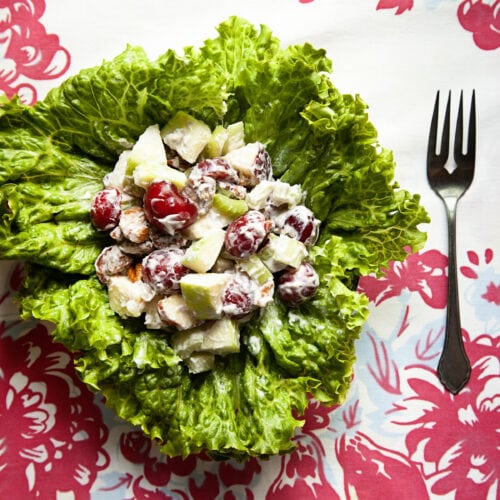
Low Histamine Waldorf Salad
Equipment
- Knife
- Apple Corer (optional)
Ingredients
- 6 Tablespoons Let's Do Organic Coconut Cream
- ½ teaspoon Redmond Real Salt
- 1 Tablespoon Lemon Juice
- 2 Apples cored and diced
- 1 cup Cherries pitted and halved (fresh or frozen)
- 1 cup Celery sliced thin
- ½ cup Pecans chopped
- 12-15 Lettuce Leaves (optional) for serving
Instructions
- If using frozen cherries, plan a little ahead. You’ll want to thaw them until just slightly frosty in the fridge. You can pull the slightly frosty cherries out of the fridge and put them on the counter while you prepare the rest of the salad. (15-20 minutes on the counter will be fine for histamine levels.) That should be enough time to get them to the right consistency and keep histamine levels low, too. If you leave them in the fridge overnight, the histamine levels will rise more.
- In a medium bowl, make the creamy dressing by combining coconut cream, salt, and, if tolerated, lemon juice.
- I use an apple corer to core the apples. I find it wastes less of the apple this way. You can just use a knife if you prefer. Core the apples then dice them.
- If using fresh cherries, remove stems. Cut in half and remove seeds. If you are using frozen cherries, cut them in half if they are whole.
- Slice celery into small, thin pieces.
- Do a rough chop of the pecans.
- Add the diced apples, chopped celery, halved cherries, and pecans to the dressing.
- Stir until combined.
- Choose how you want to serve. If you’re going traditional, lay down some clean, fresh lettuce leaves on a plate. Then, scoop the salad right on top of the lettuce leaves.
Notes
- use grass-fed, organic cream, whipped instead of coconut cream
- use only peeled golden or red delicious apples
- use peeled soft pears in place of cherries (stick with Bartlett or Bosc for low oxalate)
Nutrition
You’ll have this classic trending again with your friends and family! Let us know in the comments how you served up your Waldorf salad!
More Low Histamine Salad Ideas
Like this recipe? Here are some other salad recipes you might like to try next:
- Ranch Inspired Salad Dressing – Low Lectin, Low Oxalate, & Low FODMAP Options
- Rosemary Chicken Salad – Low Histamine, Low Lectin, and Low to Medium Oxalate Options
- Mango Blueberry Basil Salad – Low Oxalate & Low Lectin
- Baru Nut Crusted Chicken Over Salad – Low FODMAP, Low Lectin, Medium to Low Oxalate Options
Some links in this website are affiliate links, which means Mast Cell 360 may make a very small commission if you purchase through the link. It never costs you any more to purchase through the links, and we try to find the best deals we can. We only recommend products that we love and use personally or use in the Mast Cell 360 practice. Any commissions help support the newsletter, website, and ongoing research so Mast Cell 360 can continue to offer you free tips, recipes, and info. Thank you for your support!
References
Anogeianaki, A., et al. (2010). Vitamins and mast cells. International journal of immunopathology and pharmacology, 23(4), 991–996. https://doi.org/10.1177/039463201002300403
Karlovsky, P., et al. (2016). Impact of food processing and detoxification treatments on mycotoxin contamination. Mycotoxin research, 32(4), 179–205. https://doi.org/10.1007/s12550-016-0257-7
Kim, S. M., et al. (2015). Consumption of high-dose vitamin C (1250 mg per day) enhances functional and structural properties of serum lipoprotein to improve anti-oxidant, anti-atherosclerotic, and anti-aging effects via regulation of anti-inflammatory microRNA. Food & function, 6(11), 3604–3612. https://doi.org/10.1039/c5fo00738k
Li, Y., et al. (2016). Quercetin, Inflammation and Immunity. Nutrients, 8(3), 167. https://doi.org/10.3390/nu8030167
Mayo Clinic Staff. (2021, February 3). Vitamin B-6. Mayo Clinic. Retrieved May 6, 2022, from https://www.mayoclinic.org/drugs-supplements-vitamin-b6/art-20363468
Miyoshi, M., et al. (2017). Effect of dietary fatty acid and micronutrient intake/energy ratio on serum diamine oxidase activity in healthy women. Nutrition, 39–40, 67–70. https://doi.org/10.1016/j.nut.2017.03.004
Rizzo, M. R., et al. (2008). Evidence for anti-inflammatory effects of combined administration of vitamin E and C in older persons with impaired fasting glucose: impact on insulin action. Journal of the American College of Nutrition, 27(4), 505–511. https://doi.org/10.1080/07315724.2008.10719732
USDA. (2019a, April 1). FoodData Central. Retrieved May 6, 2022, from https://fdc.nal.usda.gov/fdc-app.html#/food-details/170182/nutrients
USDA. (2019b, April 1). FoodData Central. Retrieved May 6, 2022, from https://fdc.nal.usda.gov/fdc-app.html#/food-details/171719/nutrients
Weng, Z., et al. (2012). Quercetin is more effective than cromolyn in blocking human mast cell cytokine release and inhibits contact dermatitis and photosensitivity in humans. PloS one, 7(3), e33805. https://doi.org/10.1371/journal.pone.0033805

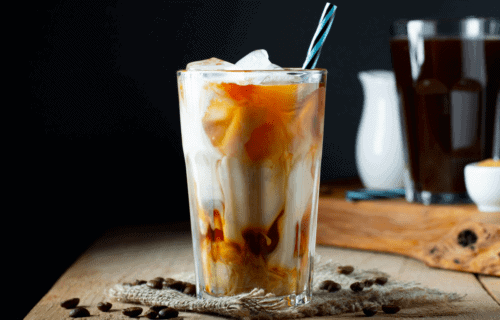
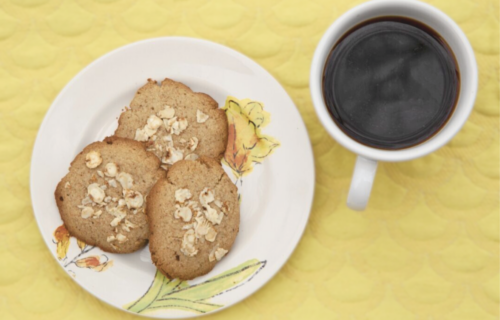
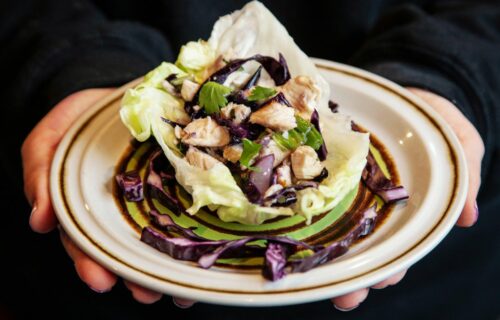
Beth, looks like great recipe! How do you use lemon juice as this is a trigger for me and other mcas overcomers?
You are a force for good in this field!
Thanks, Ginny
Hi Ginny,
Even when she was very ill, Beth could handle a little bit of lemon or lime juice. Many people in our community can handle it in small amounts from time to time, too. However, we do understand that not everyone can, so that’s why we list this as optional. Thanks for checking in! I hope this helps!